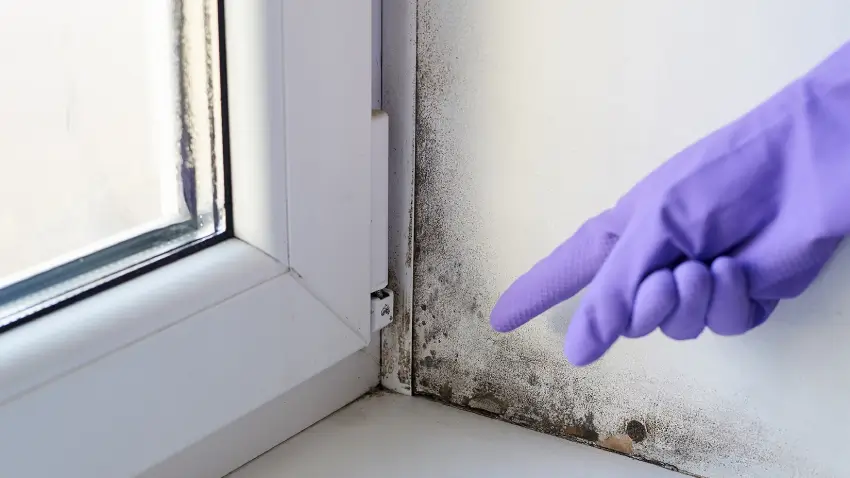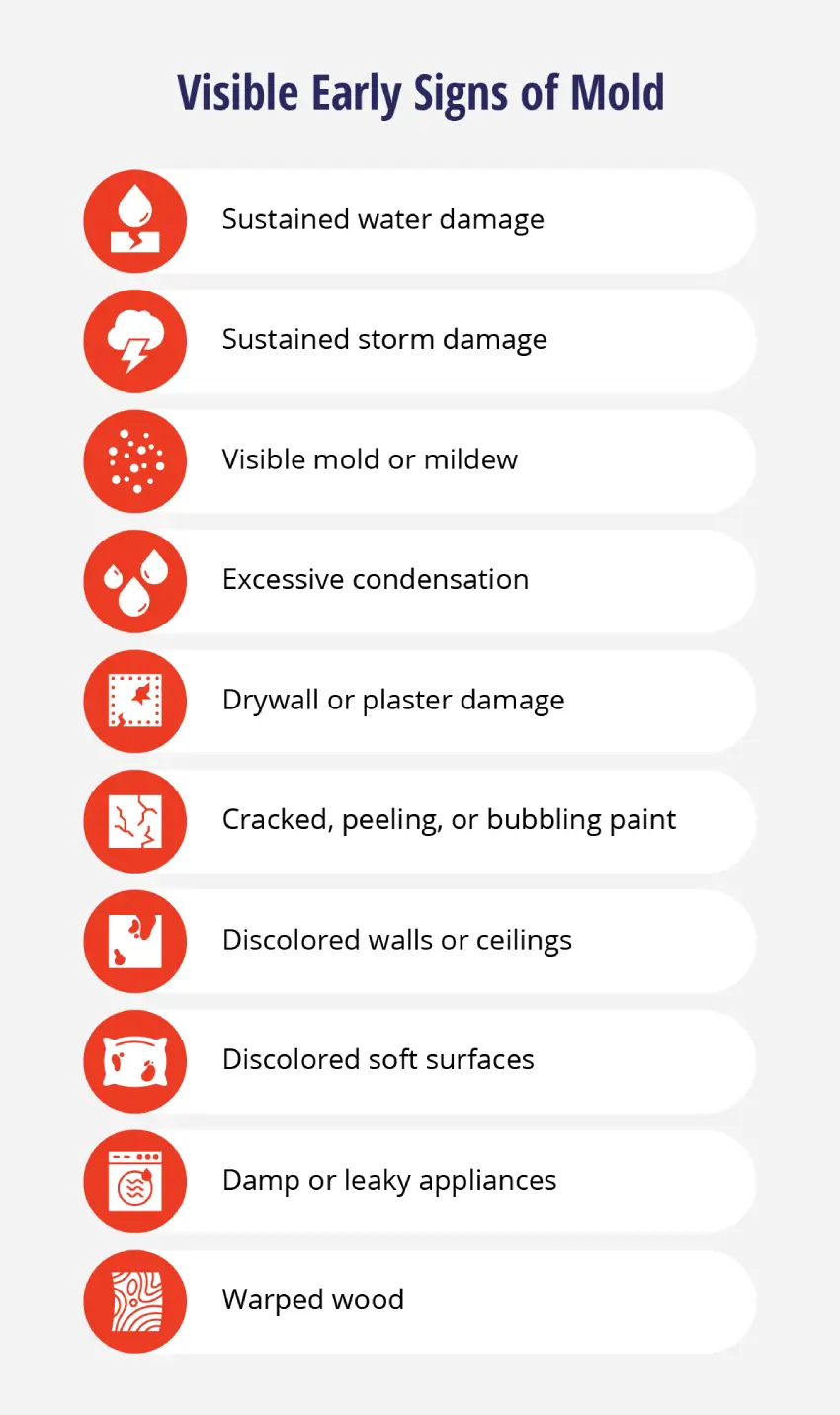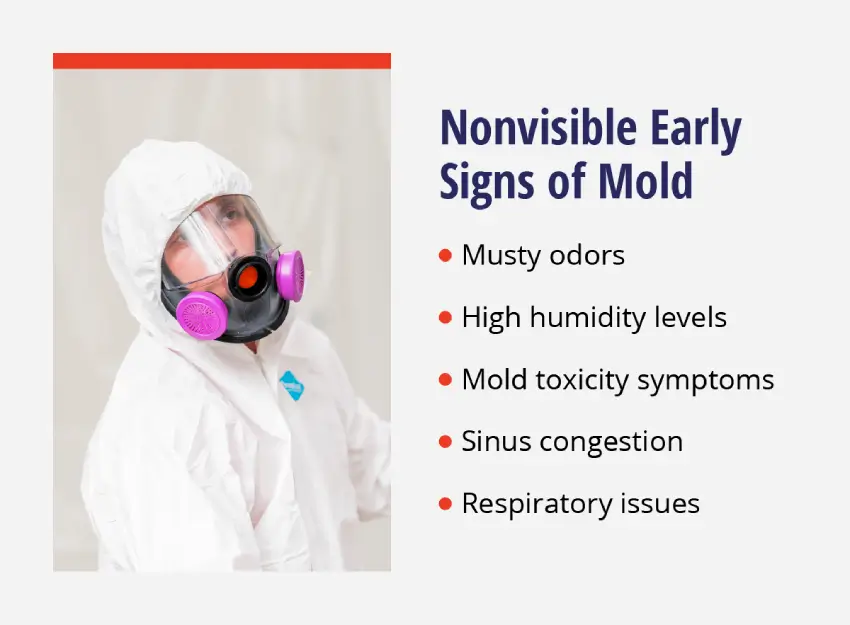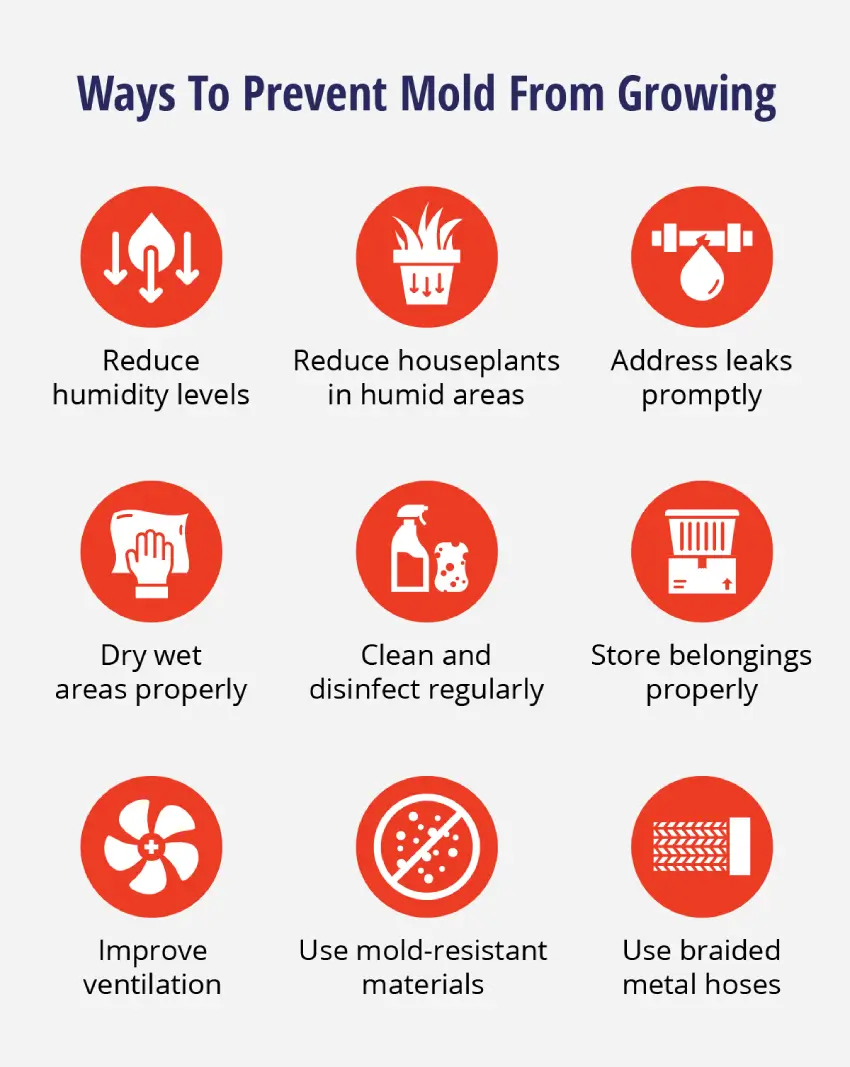
Rainbow Restoration highlights the importance of recognizing early signs of mold to prevent health risks and property damage. Key indicators include:
|
Musty odor? Unexplained sniffles? Discolored walls? These could be the early signs of mold.
Mold can grow unexpectedly, lurking behind walls or beneath carpets. In fact, mold can grow almost anywhere. The only way to prevent it is to control moisture levels.
Learn how to identify mold growth, understand the health risks, plus more tips for preventing mold.
Table of contents:
- 1. Sustained Water Damage
- 2. Sustained Storm Damage
- 3. Visible Mold or Mildew
- 4. Musty Odors
- 5. High Humidity Levels
- 6. Excessive Condensation
- 7. Drywall or Plaster Damage
- 8. Cracked, Peeling, or Bubbling Paint
- 9. Discolored Walls or Ceilings
- 10. Discolored Soft Surfaces
- 11. Damp or Leaky Appliances
- 12. Warped Wood
- 13. Mold Toxicity Symptoms
- 14. Sinus Congestion
- 15. Respiratory Issues
- Tips for Preventing Mold
- What To Do With Early Signs of Mold
- Call Rainbow Restoration® for Mold Remediation and Removal
- Mold FAQ
1. Sustained Water Damage
Leaky pipes, roof damage, or overflows can leave surfaces wet for extended periods, creating a prime spot for mold. Basements are prone to water damage, whether because of plumbing issues, poor drainage, or surface water inflow from heavy rains or snow melt. Due to its ability to penetrate and hide into porous building materials, water in a basement can be difficult to locate and remove.
Other areas of a property that are likely to sustain water damage include laundry rooms, bathrooms, and kitchens. Call Rainbow Restoration to address water damage promptly to remove the standing water, dry the structure, and eliminate chances of mold growth.
2. Sustained Storm Damage
Windblown rain or flooding from storms can leave hidden moisture in walls, ceilings, and under floor coverings. Storm damage can also cause broken windows, structural issues, torn siding, and more.
A thorough inspection after a storm can help identify any water intrusion. Service professionals will be able to address the cause of the damage and restore the property, whether the issues resulted from flooding, hurricanes, tornadoes, or other types of storms.

3. Visible Mold or Mildew
Mold appears as fuzzy patches in various colors, like black, green, or brown. Mildew, a type of mold, often manifests as flat, white patches. The main difference between mold and mildew is that mold is typically found indoors while mildew is found outdoors.
Removing visible mold and addressing the underlying moisture issue is crucial. While it may be tempting to try and tackle small areas of mold without professional help, doing so is dangerous and can worsen the problem. Always consult professionals for mold removal and remediation.
4. Musty Odors
A persistent musty odor, often described as earthy or stale, can indicate hidden mold growth. Since mold releases odors as it grows, a musty house smell can be a telltale sign of mold growth. The strength of the odor can sometimes indicate the extent of the mold problem.
It’s important to have a professional identify and address the source of any musty odors and look for leaks, condensation problems, or areas with poor ventilation that might be conducive to mold growth. Just because it isn’t visible doesn’t mean it’s not there. The mold might be growing somewhere hidden, such as the drywall or HVAC system. Call to schedule professional mold detection and removal services.
5. High Humidity Levels
Mold spores thrive in humid environments, with ideal humidity levels for mold growth ranging between 60% and 80%. Aim to keep indoor humidity levels between 30% and 50% by using exhaust fans in bathrooms and kitchens to remove excess moisture after showers and cooking. Venting dryers properly is also important to prevent moisture buildup in a home.
Property owners or managers can invest in a hygrometer to monitor indoor humidity levels if the property is in a particularly humid area and mold development is a concern. Additionally, they can utilize exhaust fans and dehumidifiers to control moisture levels.
6. Excessive Condensation
Condensation occurs when warm, moist air comes into contact with a cooler surface, causing water vapor to condense into liquid droplets. While some condensation is normal, especially during cold weather, excessive condensation on windows, pipes, and walls indicates excessive moisture in the air.
This creates a perfect environment for mold growth as mold spores thrive in damp conditions. Excessive condensation can lead to hidden mold problems within walls, ceilings, and behind furniture if left unchecked. To reduce condensation, a space needs better ventilation, less humidity, and a lower temperature.
7. Drywall or Plaster Damage
Mold can weaken and damage drywall and plaster, causing cracks, bulges, or peeling. This type of damage can be a sign of underlying moisture problems that create a breeding ground for mold growth. Not only does wet drywall and plaster create a source of moisture for mold to grow, but it’s also an organic material on which mold feeds.
Any damage to drywall or plaster should be addressed right away. The area should be inspected for the cause of damage and any additional signs of mold growth. To properly remediate mold-contaminated drywall or plaster, the materials will need to be replaced.
8. Cracked, Peeling, or Bubbling Paint
While cracked, peeling, or bubbling paint can have various causes — such as the quality or age of the paint, improper preparations, or using the wrong type of paint — it can also be a sign of a moisture problem or possible water damage.
If moisture gets trapped between the paint and the wall surface, it can create the perfect environment for mold growth. This moisture can come from leaks, condensation, or even improper surface preparation before painting.
Fix leaky pipes, improve ventilation in humid areas, and address condensation issues; don't simply repaint over cracked or peeling areas. Moldy drywall and plaster should be removed from the property and replaced.
9. Discolored Walls or Ceilings
Water damage from leaks, roof problems, or condensation can leave behind water stains on walls and ceilings, especially after having water leaking from the ceiling in the past. The color of the stain can sometimes provide clues about the source of the moisture. For example, brown or yellow stains might indicate water damage from rusty pipes, while greenish or blackish stains could indicate mold growth.
Mold itself can also discolor walls and ceilings. Mold colonies often appear as fuzzy patches in various colors like black, green, or brown. However, even in the absence of visible mold, discoloration can sometimes be a sign of hidden mold growth behind wallpaper, paint, or ceiling tiles. The source of potential moisture should be identified and repairs addressed with the help of a service professional.

10. Discolored Soft Surfaces
Mold feeds on organic matter, and soft surfaces like carpets, furniture padding, and fabrics provide a perfect food source for mold. In damp environments like bathrooms and kitchens, mold spores can readily germinate and colonize these materials, causing discoloration. The discoloration can appear as splotches, streaks, or overall darkening of the affected area, often accompanied by a musty odor.
While mold may not actually be visible, the discoloration can be a sign that it’s growing deep within the fibers of carpets, the organic soil within synthetic carpets, padding, or upholstery. This hidden mold growth can pose a significant health risk, especially for those with allergies or respiratory sensitivities. Be sure to clean these items regularly and deal with any spills immediately. Consider professional cleaning for heavily soiled or mold-affected soft surfaces.
11. Damp or Leaky Appliances
Appliances likely to cause water damage, such as dishwashers, washing machines, or water heaters, can introduce a constant source of moisture into the surrounding environment.
Often going unnoticed, this moisture can seep into nearby carpets, walls, or cabinetry, creating damp conditions ideal for mold spores to germinate and thrive. Even condensation buildup around appliances can provide enough moisture for mold growth, particularly in areas with poor ventilation.
To prevent excess moisture and leaks, ensure proper installation and venting of appliances. Inspect hoses and drainage lines regularly for leaks or cracks and address them promptly. Clean appliance surfaces and compartments to remove moisture and debris that could cause mold growth. Avoid placing furniture or objects too close to appliances, which can trap moisture and impede ventilation. Use exhaust fans in kitchens and bathrooms to remove moisture generated by these appliances.
12. Warped Wood
Warped wood can be caused by several factors, including fluctuating moisture levels. Fluctuating moisture levels will cause wood to expand and contract. Excessive moisture from water damage can cause the wood to expand more than normal, causing the wood to cup or crown. Warped wood on its own isn’t always a sign of mold growth — also look for things like discoloration and musty odor.
To prevent mold from developing on or in wood, ensure proper air circulation, especially in areas with wooden furniture or cabinetry. Good ventilation helps prevent moisture buildup that can contribute to mold growth and wood warping. Use exhaust fans in bathrooms and kitchens and promptly address any leaks or condensation problems.
13. Mold Toxicity Symptoms
Long-term mold exposure can trigger various health problems in some individuals. These symptoms can be vague and non-specific but may include headaches, fatigue, skin irritation, and respiratory problems like sinus congestion or coughing. If mold growth is the suspected reason for these symptoms, consult a healthcare professional to determine the cause and get appropriate treatment.
It's important to note that these symptoms can arise from other environmental irritants or allergies. If mold is the suspected culprit, the presence of other signs on this list, along with these health concerns, can strengthen the case for further inspection or professional mold testing.
14. Sinus Congestion
When microscopic mold spores get into the sinuses, they can cause inflammation and irritation, leading to congestion. Note various factors can cause sinus congestion, including allergies, the common cold, and even dry air.
However, if the congestion is persistent, accompanied by other signs of mold growth like a musty odor or discoloration on walls or ceilings, it becomes more suggestive of mold exposure.
Occupants should minimize the amount of time spent in areas where there’s suspected mold growth Additionally, if necessary, occupants should relocate to a mold-free environment while the mold problem is addressed by restoration professionals.
15. Respiratory Issues
Similar to sinus congestion, respiratory problems like coughing, wheezing, and shortness of breath can be early signs of mold exposure. Mold spores are airborne irritants and can inflame the airways of the lungs. People with allergies or asthma are especially susceptible, as mold exposure can worsen these conditions.
While respiratory issues can have numerous causes, mold exposure may be the culprit. Like with sinus congestion, exposure should be limited until ventilation is improved and the mold is professionally removed.

Tips for Preventing Mold
The surest way to prevent mold is to reduce the amount of moisture in an environment, including:
- Reduce humidity levels: Aim for a consistent indoor humidity level between 30% and 50% by using exhaust fans in bathrooms and kitchens after showers and cooking. Invest in a hygrometer to monitor humidity levels and dehumidifiers for areas prone to moisture buildup, like basements and crawl spaces.
- Improve ventilation: Ensure proper air circulation throughout the property. Open windows regularly, especially during and after activities that generate moisture. Consider installing ventilation systems for improved airflow.
- Address leaks promptly: Fix leaky pipes, faucets, and appliances as soon as possible. Repair roof damage and promptly clean up any spills or overflows to prevent moisture build-up that can lead to mold growth.
- Dry wet areas thoroughly: After showers, baths, or using the kitchen, squeegee or wipe down surfaces to remove excess moisture. Allow wet areas to dry completely before closing doors or cabinets.
- Clean and disinfect regularly: Routinely clean bathrooms, kitchens, and other moisture-prone areas with products approved to treat mold. Pay attention to areas around showers, tubs, sinks, faucets, and anywhere else where moisture accumulates.
- Store belongings properly: Avoid storing belongings directly against walls, especially in basements or crawl spaces. This allows for proper air circulation and prevents moisture build-up behind objects.
- Use mold-resistant materials: When renovating or replacing flooring, drywall, or other building materials, consider using mold-resistant options, especially in moisture-prone areas.
- Reduce houseplants in humid areas: While houseplants improve indoor air quality, too many plants in poorly ventilated spaces can contribute to excess moisture levels.
- Use braided metal hoses on washing machines and refrigerators: Braided metal hoses are more durable and less likely to develop leaks compared to rubber hoses. This reduces the risk of moisture build-up that can lead to mold growth.
What To Do With Early Signs of Mold
Because mold can spread very quickly, it’s important to begin the remediation process at the first early signs of mold. The first step should be to call restoration professionals to diagnose and come up with a plan to address the mold.
The service professionals at Rainbow Restoration will:
- Create a scope of work for the job and provide pricing information based on an assessment of the mold location and extent of damage. This may include bringing in an indoor environmental professional (IEP) to properly help scope the mold infestation and required work.
- Address the cause of the mold, such as burst pipes, leaky windows, or other water damage.
- Contain the infected areas by tarping to avoid mold spreading.
- Put the area under negative pressure using an air filtration device.
- Remove any mold-infested items from the area that cannot be salvaged. This may include carpeting, drywall, or furniture. Rainbow Restoration follows all EPA guidelines and the IICRC standard for safely handling and removal of mold.
- Treat the mold by sanding areas, and then wire brushing, HEPA filtering, and HEPA vacuuming.
- Restore any items offsite that can be restored. Items may be safely removed and Rainbow Restoration’s service professionals will provide a full inventory of items and document damage, along with their restoration efforts.
- HEPA filtration and vacuum by service professionals to clean the area one last time to ensure it is contaminant-free.
- Final walkthrough by the Rainbow Restoration specialist or IEP to take air samples and complete a visual inspection, validating that remediation is complete.
Call Rainbow Restoration for Mold Remediation and Removal
If any of these early signs of mold have been discovered or are suspected on a property, it’s essential to address them right away. Mold is not only an eye sore but a health risk as well. Mold remediation and removal specialists can help identify the mold, remove it safely, and provide insights into how to prevent future mold growth.
Contact the professionals at Rainbow Restoration to remove mold from a property quickly and safely.
This article is intended for general informational purposes only and may not be applicable to every situation. You are responsible for determining the proper course of action for your property. Services should be performed by licensed and experienced professionals. Rainbow Restoration is not responsible for any damages that occur as a result of this blog content or your actions. For the most accurate guidance, contact a Rainbow Restoration professional for a custom, on-site assessment.
Mold FAQ
What Are the First Signs of Mold?
The first signs of mold can be subtle. A musty odor, discoloration on walls or ceilings, or visible mold growth are all signs of mold. Building occupants might also experience sinus congestion or respiratory issues if mold is present.
What Does the Beginning of Mold Growth Look Like?
The beginning of mold can look like small, fuzzy patches in various colors like black, green, or brown on walls, ceilings, or floors. It may also present as a musty odor even before visible mold appears.
Is It Possible To Have Mold Without Knowing It?
Yes, it is absolutely possible to have mold without knowing it. Mold spores are everywhere, both indoor and outdoor, waiting for the right conditions to feed on organic materials to grow.
How To Know if Mold Is Making Someone Sick?
Mold exposure mimics other allergies or illnesses. Persistent sinus congestion, respiratory issues, or headaches, along with other signs of mold growth, can indicate mold exposure. Consult a medical professional to discuss the possibility of mold-related health problems.
Is Mold Dangerous?
Yes, mold can be dangerous for some people. While not all mold is harmful, exposure can trigger allergic reactions and respiratory problems in some individuals. For those with compromised immune systems, mold can cause more serious health issues.
